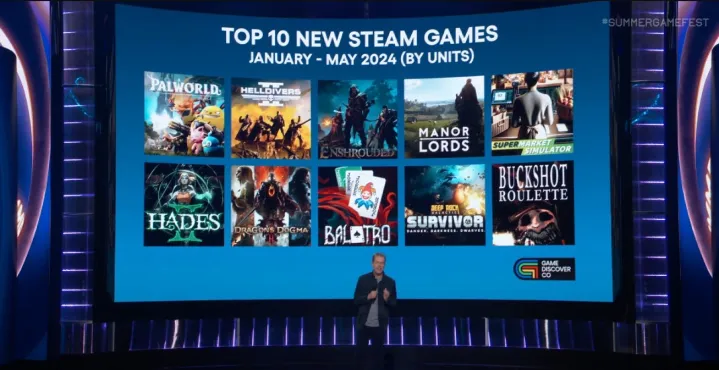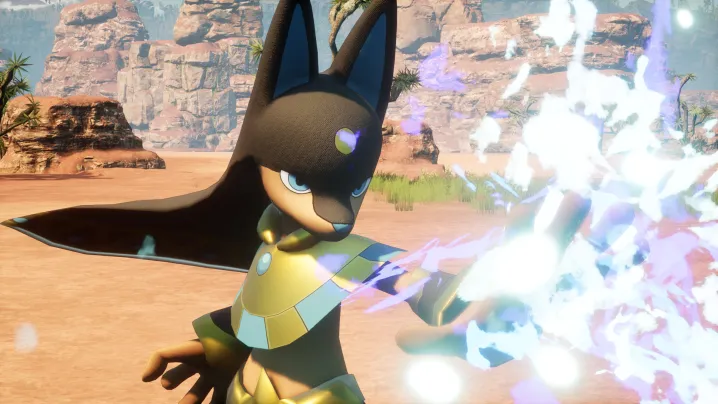

When Geoff Keighley takes the stage at an event like The Game Awards, he doesn’t tend to talk about current events. That’s been a point of frustration for some people over the years who have voiced criticism over how the gaming figurehead uses (or misuses) his platform. As Keighley walked on the stage at this year’s Summer Game Fest, expectations that he’d acknowledge the current layoff crisis in the video game industry were low. Then Keighley delivered the show’s biggest surprise in its first minute.
“This has been a tumultuous and difficult year with company layoffs and studio closures which have disappointed all of us. But there’s also something else happening,” Keighley said to open the show before flipping to a slide showing the top 10 bestselling new games on Steam so far in 2024. The list wasn’t filled with blockbusters; it was topped by surprise success stories like Palworld, Balatro, and Manor Lords.
“Our industry is evolving and changing. And thanks to digital distribution, smaller teams and new creators are finding incredible success … Two of them are considered big company games, but the other eight come from indie, midsized teams, or indie developers. I look at this list and I get inspired that new ideas, new teams, and smaller creators can and will break through. It’s a reminder to big companies that they have to treat their developers right, because today there are many paths to sustainability and success. And that’s what makes this industry so, so great.”
It was a big moment for Keighley, which saw him directly addressing his critics and accepting the responsibilities that come with a high-visibility platform like his. But that moment wasn’t just about Keighley; it set an important narrative about where the video game industry is headed that was threaded throughout the showcase. By the end of the event, the message was clear: Indies are the next frontier for big publishers hunting for a more sustainable future.
Going independent
It’s no secret that the video game industry has been in a freefall. We’ve seen over 10,000 workers laid off already in 2024 across publishers big and small. Xbox has laid off thousands on its own, even shuttering beloved studios like Tango Gameworks entirely. Polygon reports that 2024 has already seen more layoffs across gaming than all of 2023 combined — and its only June. It’s a dire situation, and one that underlines a need for change. Ballooning budgets, eight-year development cycles, and enormous “megagames” are no longer sustainable strategies. But what’s the alternative?
The recurring answer at Summer Game Fest was by going small. Keighley made a more concerted effort this year to showcase indie games like Killer Bean alongside Harry Potter and other IP behemoths. There’s a cynical read on Keighley’s opening monologue; one could see it as a way to tightly control the narrative of a live stream that lacked high-profile “world premieres,” as if to convince audiences tuning in for big reveals that they care about indies more than they think. That would be a smart way to set expectations upfront and paint a focus on smaller games as intentional, rather than the byproduct of the tangible impact layoffs are having on big games.

Putting that take aside, Summer Game Fest did paint a sincerely cogent narrative about sustainability. That became apparent in two moments. One was when Among Us creator Innersloth revealed its new publishing initiative, Outersloth, that’s meant to elevate promising indies in need of help. Innersloth’s Victoria Tran called the initiative a “passion project and dream for a better industry.”
The more crucial moment, though, came just before that, when Blumhouse Games got a long segment introducing its mysterious publishing plans. While players may have been expecting the Hollywood megapower to reveal some glitzy horror games, that’s not what happened. Instead, we saw a reel of tiny indies. Fear the Spotlight, for instance, is a retro throwback made by two people. In an onstage segment after the reveal, Blumhouse CEO Jason Blum took the stage to explain his company’s gaming mission.
“We wanted to try and take our approach to movies and apply it to games, and that’s what you see here,” Blum said during the show. “We’re going to do independent games. We’re going to look for creators and give them a platform, and encourage these creators to be weird and subversive, and find the most effed up, scariest things they can and put them into very cool games.”
Both moments sent a clear message: Publishers see a path forward in backing the kinds of small games that appeared in Keighley’s opening slide of Steam success stories. That philosophy isn’t just present in companies like Blumhouse. Xbox has already claimed the meteoric success of Palworld, which launched on Xbox Game Pass, as a win for the company. Even Sony has seen the fruits of that effort, as Helldivers 2, from indie Swedish studio Arrowhead, has proven to be a surprise smash hit for the company. While megagames like Final Fantasy VII Rebirth struggle to meet sales expectations, smaller games are paying off for big publishers.
New Hollywood
While this may be an emerging trend for video games, it’s not unprecedented for the arts at large. In fact, what’s happening in gaming right now has a direct equivalent in cinema history. In the 1950s, Hollywood was working through its own collapse following its golden age. There were several factors, including a 1948 Supreme Court ruling that broke up the studio system, as well as TV’s rise in popularity. Soon, the kinds of big, templatized epics that Hollywood thrived on were no longer sustainable — especially as they weren’t connecting with younger moviegoers.
In a Hail Mary attempt to save the industry, studios began to take bigger risks in an attempt to find a new audience. That era was dubbed New Hollywood. Rather than doubling down on war epics and musicals, they began funding films from young, independent directors who were going against the grain. Soon, then-unknown filmmakers like Martin Scorsese and Steven Spielberg rose to prominence. And while that method occasionally produced costly flops, it also revitalized public interest in movies. It was the fresh blood Hollywood needed to stay alive.

The moment we saw at Summer Game Fest indicates that the video game industry is on the cusp of its own New Hollywood moment. We’re rapidly approaching a future where major publishers begin funding and pushing indie projects from small developers with proven success, rather than relying on big-budget megagames. Don’t be surprised if you see publishers like Xbox striking deals with developers like Palworld‘s Pocket Pair Inc. to make their next projects for them.
Will that strategy pay off? It’s a risk, just as it was for Hollywood in the 1960s. It’s hard to predict what games will be hits, especially when dealing with left-field elevator pitches like “poker roguelike.” And just because a developer hits gold once doesn’t mean its second game will see the same success. Independent development has its own set of hurdles, too; it’s not a magic cure for the industry’s problems. After all, the whole New Hollywood experience largely ended after the success of Star Wars pushed studios back into making templatized blockbusters rather than gambling on wild ideas. Publishers could toss indies to the side the moment Grand Theft Auto 6 launches and gobbles up cash.
Until then, pay close attention to the kinds of small games that top the Steam charts from left field. The studios behind those games might just create your next favorite PlayStation or Xbox exclusive.



